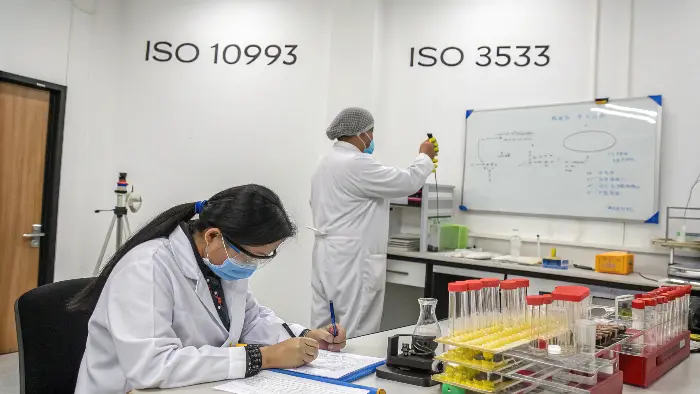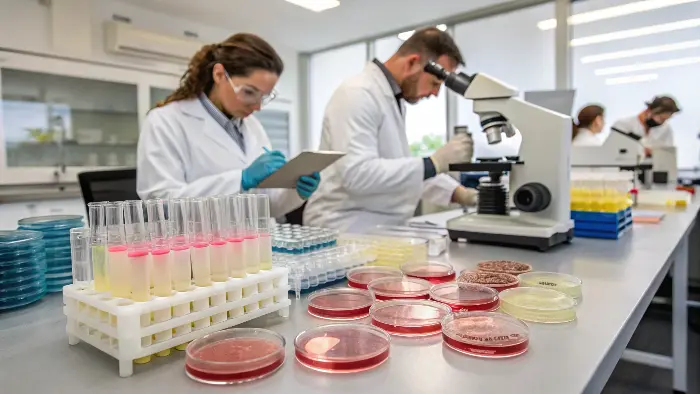Worried about product safety? Adult toys directly contact sensitive areas. Ensuring material biocompatibility isn’t just good practice; it’s crucial for user trust and health.
Biocompatibility testing for adult toys involves lab protocols ensuring materials won’t cause adverse reactions. Key standards like ISO 10993 (for medical devices, often adapted) and specific industry guidance (like aspects of ISO 3533 for sex toys) help verify non-toxicity and user safety.
Okay, "biocompatibility" – sounds a bit science-y, right? But trust me, as someone who’s dedicated years to making pleasure products at PrivyPlay, this is one of the most important topics we deal with. It’s not just about a toy looking good or feeling good in the hand; it’s about making sure it’s safe for the most intimate parts of the body. Customers are putting a lot of trust in us, and biocompatibility testing is how we honor that trust. It’s a non-negotiable for any reputable brand. I mean, if you’re a brand owner or sourcing manager, this is your reputation on the line! So, let’s break down what this really means and why it’s so vital for anyone in the adult products industry.
What Exactly IS Biocompatibility and Why Is It a Huge Deal for Adult Toys?
Ever wonder if the materials in adult toys are actually body-safe? It’s a valid concern! Poor materials can lead to irritation, allergies, or worse, harming your customers and your brand’s reputation. This isn’t something to skimp on.
Biocompatibility refers to how a material interacts with biological systems. For adult toys, it means the material shouldn’t cause harmful effects like skin irritation, sensitization (allergies), or toxicity when in contact with mucous membranes or skin.
| So, let’s get down to brass tacks. "Biocompatibility" simply means that a material is compatible with living tissue. It won’t cause a bad reaction when it comes into contact with the body. Now, why is this a massive deal for adult toys? Well, think about where these products are used – often in direct contact with some of the most sensitive and absorptive tissues in the human body, like mucous membranes. And sometimes, for extended periods! If a material isn’t biocompatible, you could be looking at a whole host of problems for your customers: skin irritation, redness, itching, allergic reactions (sensitization), or even chemical leaching where harmful substances from the material get absorbed by the body. Not good. 👎 At PrivyPlay, we see this as absolutely fundamental. Our slogan is ‘Elevating Pleasure, Empowering Confidence’ – you can’t have either of those if there’s a lingering doubt about safety! I remember early in my manufacturing career, way before PrivyPlay, seeing some really questionable materials being pushed in the market. Stuff that was cheap, sure, but you just knew it wasn’t right. That was a huge motivator for me to build a brand focused on quality and, above all, safety. It’s personal for me, and it should be for any responsible brand owner. Here’s a quick look at what we want versus what we want to avoid: |
Desired Material Properties | Potential Adverse Reactions from Poor Materials |
|---|---|---|
| Non-toxic | Cytotoxicity (cell damage/death) | |
| Non-irritating | Skin or mucosal irritation (redness, swelling) | |
| Non-sensitizing (hypoallergenic) | Allergic reactions, sensitization | |
| Chemically stable (no leaching) | Chemical burns, systemic toxicity | |
| Smooth, non-porous (for hygiene) | Bacterial growth, infections |
It’s not just about external skin contact either; internal use products have an even higher bar for safety. Making sure every material that goes into a PrivyPlay product meets stringent biocompatibility standards is a cornerstone of our design and manufacturing process.
Which Key Laboratory Protocols and Standards Should We Know for Biocompatibility Testing?
Navigating the world of testing standards can feel like alphabet soup. ISO this, USP that… which ones actually matter for ensuring adult toy material safety and keeping your customers happy and, more importantly, safe?
The primary global standard for biocompatibility is ISO 10993, "Biological evaluation of medical devices." While adult toys aren’t medical devices, its principles and specific tests (like cytotoxicity, sensitization, irritation) are widely adopted. ISO 3533 also offers guidance specifically for sex toys.

Alright, so we know why biocompatibility is crucial. Now, how do we actually prove a material is safe? This is where testing standards and protocols come in. You can’t just say a material is safe; you need to test it.
The big one you’ll hear about is ISO 10993. This is an international standard titled "Biological evaluation of medical devices." Now, I know what you’re thinking – "but adult toys aren’t medical devices!" And you’re right, legally they’re often classified differently. However, because ISO 10993 is so comprehensive and globally recognized for materials that come into contact with the body, its principles and specific test methods are the go-to for responsible adult toy manufacturers. Think about it – if a material is deemed safe enough for a medical implant or a catheter, it’s a pretty darn good starting point for an intimate toy, right?
Here are some key parts of ISO 10993 that we pay close attention to:
- ISO 10993-1: This part outlines the general principles for evaluation and testing within a risk management process. It helps decide which tests are needed based on the nature and duration of body contact.
- ISO 10993-5: Tests for in vitro cytotoxicity. This is a biggie. It checks if extracts from the material are toxic to cells grown in a lab. We want to see that the material doesn’t kill or damage cells. It’s a fundamental screening test, and a fail here is a major red flag.
- ISO 10993-10: Tests for irritation and skin sensitization. This looks for potential to cause irritation (like redness or inflammation) or to trigger an allergic reaction (sensitization) after repeated contact. Super important, as these are common complaints if materials aren’t up to scratch.
-
ISO 10993-3: Tests for genotoxicity, carcinogenicity, and reproductive toxicity. For materials with very long-term or extensive internal contact, these more in-depth tests might be considered to ensure no risk of genetic damage, cancer, or harm to reproduction. This is serious stuff!
Then there’s ISO 3533, which is more recent and titled "Sex toys – Design and safety requirements." This standard is specifically for our industry and does address material safety, often by referencing or aligning with principles from ISO 10993. It’s good to be aware of this one too.
You might also hear about USP Class VI (United States Pharmacopeia). This is often cited for plastics and rubbers used in medical devices and containers. If a material meets USP Class VI, it’s generally considered to have a high level of biocompatibility.
When we at PrivyPlay are sourcing a new silicone or TPE, for example, we specifically look for suppliers who can provide comprehensive test reports, often against ISO 10993-5 and -10 at a minimum. If they can’t, or if the reports look dodgy, that’s a hard pass for us. It might mean a slightly higher material cost to get the good stuff, but the peace of mind for us and our customers is absolutely priceless. 🔥Standard Relevance to Adult Toys Key Tests Often Referenced ISO 10993-1 Framework for biological safety evaluation Risk assessment, test selection guidance ISO 10993-5 Assesses if material is toxic to cells In vitro cytotoxicity tests (e.g., MEM Elution) ISO 10993-10 Assesses potential for irritation & allergic reactions Irritation tests, Skin sensitization tests (e.g., LLNA) ISO 3533 Specific safety standard for sex toys Material safety, physical hazards, chemical safety USP Class VI High standard for plastics/rubbers in medical applications Systemic toxicity, intracutaneous, implantation tests What Are the Common Biocompatibility Tests Performed on Adult Toy Materials?
So we know why testing is important and which standards exist, but what actually happens in the lab? Are they just dunking toys in beakers, or is it more complex? Let’s peek behind the curtain.
Common lab tests include cytotoxicity (cell toxicity), sensitization (allergic potential), irritation (skin/mucosal reaction), and sometimes material characterization to identify leachables or extractables. These ensure materials are inert and non-harmful during use.

Okay, so your manufacturer says they use "body-safe silicone." Great! But how do they know? They (or a third-party lab) actually perform specific tests. Let’s talk about some of the most common ones you’ll see on those test reports.
- Cytotoxicity Testing (e.g., ISO 10993-5): This is usually the first hurdle. Scientists take extracts from the material (by soaking it in a solution) and then expose living cells (often L929 mouse fibroblast cells, a standard cell line) to these extracts in a petri dish. They then observe if the cells die, stop growing, or show signs of damage. Basically, does the material release anything that’s toxic to cells? Sounds dramatic, but it’s a crucial screening. If a material fails this, it’s generally a no-go for intimate contact.
- Irritation Testing (e.g., ISO 10993-10): This test checks if the material causes a localized inflammatory reaction on skin or mucous membranes. For example, extracts of the material might be applied to the skin of test subjects (often rabbits, though animal-free alternatives are gaining traction) or, for products intended for internal use, to sensitive tissues like vaginal mucosa. Scientists then look for signs like redness, swelling, or other irritation. This tells us if the product is likely to cause immediate discomfort.
- Sensitization Testing (e.g., ISO 10993-10): This is different from irritation! Irritation is a direct, often immediate, reaction. Sensitization is an allergic reaction that develops over time with repeated exposure. Once someone is sensitized to a substance, they’ll likely react every time they’re exposed. Not what you want for a pleasure product! Common tests include the Guinea Pig Maximization Test (GPMT) or the Local Lymph Node Assay (LLNA) in mice, which assess the material’s potential to trigger an immune response leading to an allergy.
-
Chemical Characterization (Extractables & Leachables, e.g., ISO 10993-18): This is a more advanced and often more expensive step. It involves chemically analyzing the material to identify any substances that could potentially "leach" out during use (leachables) or that can be "extracted" under more aggressive lab conditions (extractables). This helps understand exactly what chemicals might come into contact with the user. This is especially important for novel materials or if earlier tests show borderline results. "What’s in this stuff, really?" – this test answers that.
We once had a prototype for a new product with a unique textured surface. It felt amazing in the hand, and the design was spot-on. But the initial cytotoxicity results came back, let’s say, "not great." It was borderline. We could have maybe tried to argue it, but no way. We went straight back to our material supplier and worked with them to tweak the silicone formulation. It caused a delay of a few weeks, which is never fun when you’re excited to launch. But launching a product that might cause a problem for even one customer? Absolutely not an option. That’s the kind of commitment to safety I’m talking about. It’s an investment, not an expense.Test Type Purpose Typical Method Example(s) What It Tells Us Cytotoxicity Is the material toxic to cells? MEM Elution (ISO 10993-5) If material releases cell-damaging substances. Irritation Does it cause immediate skin/mucosal inflammation? Intracutaneous, Vaginal Irritation (ISO 10993-10) Likelihood of causing redness, swelling on contact. Sensitization Can it cause an allergic reaction over time? GPMT, LLNA (ISO 10993-10) Potential to trigger an immune-mediated allergy. Chemical Characterization What chemicals could leach/extract from the material? GC-MS, LC-MS (ISO 10993-18) Identifies and quantifies potential migrant chemicals. How Can I Ensure My Manufacturer is Following These Protocols?
You’ve chosen your materials, but how do you really know your manufacturer is up to snuff with safety testing? It’s your brand on the line, so trust but verify! This is super important.
Request material safety data sheets (MSDS/SDS) and biocompatibility test reports (e.g., ISO 10993 compliant) from your manufacturer for the specific materials used. Ask about their quality control for incoming materials and batch testing.

This is where the rubber meets the road, especially for you as a brand owner or sourcing manager. You’re putting your trust – and your customers’ trust – in your manufacturer. So, how do you make sure they’re actually doing what they say they’re doing regarding biocompatibility?
First off, due diligence is key when selecting a manufacturing partner. Don’t just go for the cheapest quote. Ask the tough questions about safety and quality right from the start.
Here’s what you should be asking for and looking out for:
- Material Certifications & Test Reports: Don’t just accept a vague statement like, "Yes, we use body-safe materials." Ask for the actual test reports for the specific materials being used in your products. These reports should ideally be from accredited third-party laboratories and reference relevant standards like ISO 10993. Check the dates on the reports – are they recent? Do they apply to the exact grade of material? "Can I see the paperwork?" should be your mantra. At PrivyPlay, we have these documents ready because we know how important it is.
- Material Safety Data Sheets (MSDS/SDS): While not biocompatibility reports themselves, an SDS provides information on the chemical composition and potential hazards of a raw material. It’s another piece of the puzzle.
- Traceability: Can the manufacturer trace a specific batch of your finished products back to the particular batch of raw material used and its corresponding test reports? This is crucial for quality control and in case any issues ever arise.
- Quality Control for Incoming Materials: What is their process for verifying the materials they receive from their suppliers? Do they just trust their supplier, or do they have their own checks, perhaps even re-testing critical materials periodically?
- In-House vs. Third-Party Labs: While some large manufacturers might have capable in-house labs, test reports from independent, accredited third-party laboratories generally carry more weight as they are seen as more unbiased. We at PrivyPlay use a mix, but for key biocompatibility validations, especially for new materials, we often opt for third-party labs. It costs more, yes, but that extra layer of verification is worth its weight in gold.
- Factory Audits: If you have the means, conducting (or hiring someone to conduct) a factory audit that specifically looks at their quality management systems, material handling, and documentation for safety testing can be very revealing.
Red flags to watch out for:- Vagueness or evasiveness when you ask about safety testing.
- Reluctance to share test reports or certifications.
- Providing generic company certifications instead of material-specific reports.
-
Test reports that look old, incomplete, or from non-accredited labs.
I always tell our clients at PrivyPlay, and any brand owner I speak to: if a potential manufacturer is cagey about their safety testing and documentation, seriously consider walking away. There are plenty of manufacturers out there, like us, who are proud of our commitment to safety and are transparent about our processes. This isn’t just about making toys; it’s about people’s well-being. Your customers deserve that peace of mind, and so does your brand.Verification Method What to Look For Why It’s Important Request Test Reports ISO 10993 compliance, recent dates, specific material Concrete proof of biocompatibility testing. Ask about Supplier QC Process for verifying incoming raw materials Ensures consistency and safety of base materials. Check Lab Accreditation Are tests by ISO 17025 accredited labs? Adds credibility and reliability to test results. Inquire about Traceability Can link finished product to material batch & tests? Essential for quality control & issue resolution. Look for Transparency Willingness to share info, answer questions openly Indicates a commitment to safety and good practices. Conclusion
Biocompatibility testing isn’t optional; it’s essential for user safety and brand integrity in the adult toy market. Prioritize it by understanding standards, demanding proof, and partnering with responsible manufacturers like PrivyPlay who make it a non-negotiable.
